How to Start a Quilting Bee
Hello everyone! Our
recent chat stirred up lots of thought, one of which was a reminder to get back to the basics. Many of you may be newer to the online sewing scene and curious about how entities like virtual quilting bees come to be. I'd love to share with you the details and hope you'll feel empowered to start a bee of your own! And, just for fun, I've peppered this post with photos of quilts made by various circles of
do. Good Stitches {a Charity Bee}.
What is a Quilting Bee?
Today's online quilting bees are small groups of quilters who come together to make quilts as a community, physically working on blocks for each others quilts. Members communicate through email, Flickr groups and/or dedicated bee blogs and send materials back and forth to each other through the mail.
The most common virtual quilting bee model has 12 members who work on one member's quilt each month. So, each member is assigned a month in the year. In advance of your month you gather fabric for your quilt and decide on a design. When it's your month, you send out fabric to each member, along with instructions, and they return a finished block or two to you. At the end of your month you would have lots of blocks all ready to be assembled! In this quilting bee model, most bees last a full year so that each member has a turn to get help on her quilt. Every month you are working on someone's quilt, which introduces you to many different styles and color schemes. It is vital that all members are committed for the full year so that those who are assigned later months in the year aren't neglected.
One alternative bee model is the famous 3x6 Sampler Quilt Bee that only involves a commitment of 2.5 months, but you must make 6 blocks in that time frame. This one is always open to new members, so if you want to test the waters, pop in to try a bee there.
Another stand out is the "round robin" bee style where each member starts her own quilt and then sends it to the next member who adds to the quilt and then sends it on again. The quilts continue to rotate through all hands until they return to the original maker having evolved slowly into something really special.
The do. Good Stitches bee is a bee variation in which each circle of ten members makes one quilt per month for charity. We sew with fabrics from our own stash, rather than shipping around fabric, and not all members are responsible for designing/finishing quilts, in order to make the bee more welcoming to new quilters. Do. Good Stitches adds new circles every few months, so there is no cap on our membership.
For another look at online quilting bee's see Oh, Fransson!'s post published 2 years ago. You can sometimes locate new bees that are looking for members through this Flickr thread.
Start Your own Quilting Bee!
If you'd like to try a quilting bee, you don't have to wait around for an invitation! If you have some admin skills, this is something you can definitely do. Here are some places to start:
:: Theme:: A theme is not strictly necessary, but it often inspires members to join. What would you like to work with? Nothing is too simple or too advanced, as your theme will draw the right members. If you're new to quilting, maybe a bee that works with log cabin blocks or pulls from any 9-patch block design? To push your quilting skills, your bee could focus on paper piecing, curved piecing or improv style work. Your theme doesn't have to be about construction. It could be that your blocks will include linen, embroidery, all solids or even a favorite fabric collection. I suggest you find a unifying theme that also leaves room for members to experiment.
:: Structure:: How many members? How many months will it run? How much are members expected to sew? Do they use their own fabric or fabric that is mailed? Before deciding spend some time looking at how other bees are structured to get a feel for your options. Asking folks (and yourself) to commit to a modest time frame may be a wise choice for your first bee, especially if your members are not already acquainted.
:: Meeting Place:: A virtual bee doesn't meet in person, but "meet" it must! Most folks join a bee to make friends. Where can you develop relationships, as well as keep up with logistical details like who has mailed blocks, received blocks or what the sewing instructions are for this month? Flickr groups are a free and popular solution. I love them! Some groups also start a private blog that all members can post on so that it's a discussion group. Although I haven't used one myself, it sounds like a Google+ circle might be another way to meet virtually for more real-time interaction.
:: Presentation:: The way in which you present your idea is key to garnering members. Spend time coming up with a name that captures your theme. Also, it's ideal to develop a square graphic or "button" that is like a logo for your bee. You can use this button on your Flickr group or blog as well as share the image with members who might want a bee badge for their blog. If you are not graphically inclined maybe someone who is joining your bee would be willing to make a button?
:: Members:: So, how do you get members? Most folks who start bees are bloggers with small followings. You don't need to be uber popular to start a bee! After doing the work above you have a clear invitation to extend. You can either post a general invitation on your blog or contact people you know from blogland and Flickr to invite on an individual basis. These individual invites tend to be most common, which is why you typically don't hear about a bee until it is already formed. You could also get some members individually and then post an invite on your blog along the lines of "I need 4 more members!" Another place to reach out to people is in this ongoing Flickr thread.
When you invite people, paint a picture of your theme and clearly detail the structure you have in mind. But also be open to feedback, be flexible. Make sure your would-be members know that they'll be expected to follow through the entire way. Expect that some people will decline. This is not about you! We all have lots of obligations, so even a fabulous idea has to be turned down quite often. Remember that and just keep asking!
:: Sticky Situations:: Every bee needs a leader to usher it through those unfortunate events that will pop up. Sometimes blocks will get lost in the mail. Are any members willing to make "angel blocks" to help out or will the missing blocks be replaced by the mailer or perhaps not replaced at all? What if a member is chronically late with her blocks? Be sure to set a deadline for mailing blocks and think about how you can encourage promptness. Sometimes someone disappears altogether. Life can deal us unexpected turns. Unfortunately, drop-outs are a common problem even in bee models that rely on members to stay the course. You can probably replace members who aren't able to continue if their month to quilt has not yet come up (thus the new member will still have a turn to get help on her own quilt). But, if the drop-out's quilt has already been done by your bee, it's going to be tough. That's why it's extremely bad etiquette to drop out of a bee that has already sewn blocks for you. If you find yourself struggling to meet your obligations, be sure to talk to your bee leader. She definitely wants to help find a solution, even if it means lightening your load. The worst thing to do is to disappear without communicating.
I did it and You can to!
When I started do.Good Stitches, I had only been blogging for a few months and had only made 2-3 quilts. I had never been in a bee before. Yes, I was not at all sure that I'd find anyone who would join my bee, but my mama always says, "It never hurts to try!" If you have some sort of admin skills and the passion for it, I'm sure you can start a bee. Just go for it! You'll learn as you go. Be flexible, listen to feedback, give others the benefit of the doubt and above all Have Fun!
Quilting bees are so popular precisely because they are a ton of fun. For a quilter, what's better than learning new skills, trying new things and making new friends all at once? I encourage everyone, even if you are really new to quilting, to consider a quilting bee. Just be honest about your skill level. It's nothing to be shy about! Be realistic about how much you can take on, since people will be relying on you, but don't be afraid to volunteer. A dedicated and friendly heart is more important than having perfect points in most cases!
You may also enjoy Alissa Haight Carlton & Kristen Leijnieks' book Block Party: The Modern Quilting Bee . It shares the quilts made throughout a 12-month bee, along with reflections from the members and more tips on starting your own.
. It shares the quilts made throughout a 12-month bee, along with reflections from the members and more tips on starting your own.
Good luck!
What is a Quilting Bee?
Today's online quilting bees are small groups of quilters who come together to make quilts as a community, physically working on blocks for each others quilts. Members communicate through email, Flickr groups and/or dedicated bee blogs and send materials back and forth to each other through the mail.
 |
| Seeing Stars by Imagine Circle, quilted by Amanda at My Sewcial Hour |
The most common virtual quilting bee model has 12 members who work on one member's quilt each month. So, each member is assigned a month in the year. In advance of your month you gather fabric for your quilt and decide on a design. When it's your month, you send out fabric to each member, along with instructions, and they return a finished block or two to you. At the end of your month you would have lots of blocks all ready to be assembled! In this quilting bee model, most bees last a full year so that each member has a turn to get help on her quilt. Every month you are working on someone's quilt, which introduces you to many different styles and color schemes. It is vital that all members are committed for the full year so that those who are assigned later months in the year aren't neglected.
One alternative bee model is the famous 3x6 Sampler Quilt Bee that only involves a commitment of 2.5 months, but you must make 6 blocks in that time frame. This one is always open to new members, so if you want to test the waters, pop in to try a bee there.
 |
| Old School Library by Trust Circle, quilted by Kate of Swim Bike Quilt |
Another stand out is the "round robin" bee style where each member starts her own quilt and then sends it to the next member who adds to the quilt and then sends it on again. The quilts continue to rotate through all hands until they return to the original maker having evolved slowly into something really special.
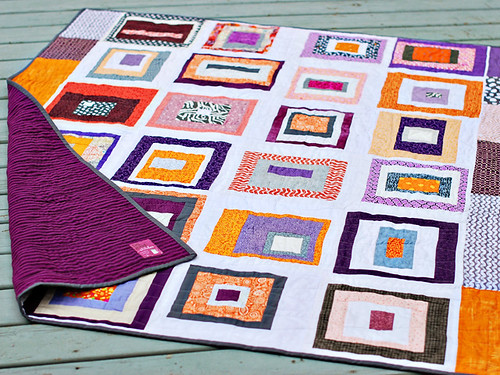 |
| Sherbet Squares by Inspire Circle, quilted by Holly of Bijou Lovely |
The do. Good Stitches bee is a bee variation in which each circle of ten members makes one quilt per month for charity. We sew with fabrics from our own stash, rather than shipping around fabric, and not all members are responsible for designing/finishing quilts, in order to make the bee more welcoming to new quilters. Do. Good Stitches adds new circles every few months, so there is no cap on our membership.
For another look at online quilting bee's see Oh, Fransson!'s post published 2 years ago. You can sometimes locate new bees that are looking for members through this Flickr thread.
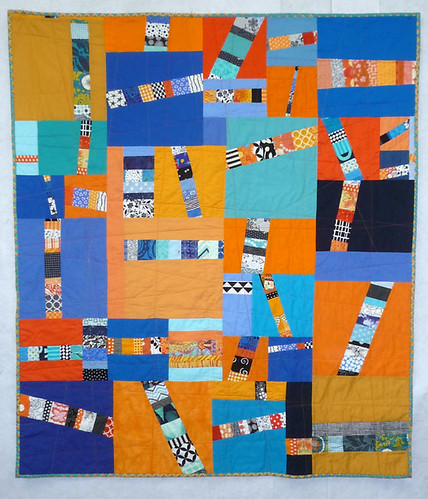 |
| by the Bliss Circle, quilted by Linda Beth of Surrounded by Scraps |
Start Your own Quilting Bee!
If you'd like to try a quilting bee, you don't have to wait around for an invitation! If you have some admin skills, this is something you can definitely do. Here are some places to start:
:: Theme:: A theme is not strictly necessary, but it often inspires members to join. What would you like to work with? Nothing is too simple or too advanced, as your theme will draw the right members. If you're new to quilting, maybe a bee that works with log cabin blocks or pulls from any 9-patch block design? To push your quilting skills, your bee could focus on paper piecing, curved piecing or improv style work. Your theme doesn't have to be about construction. It could be that your blocks will include linen, embroidery, all solids or even a favorite fabric collection. I suggest you find a unifying theme that also leaves room for members to experiment.
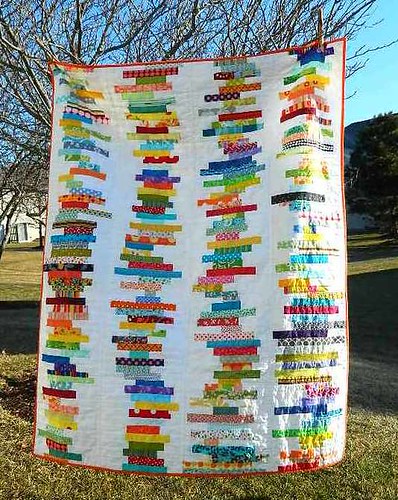 |
| Stacked Books by Trust Circle, quilted by Svetlana of S.O.T.A.K. Handmade |
:: Structure:: How many members? How many months will it run? How much are members expected to sew? Do they use their own fabric or fabric that is mailed? Before deciding spend some time looking at how other bees are structured to get a feel for your options. Asking folks (and yourself) to commit to a modest time frame may be a wise choice for your first bee, especially if your members are not already acquainted.
 |
| Boy's Quilt by Dream Circle, quilted by Lindsey of L.R. Stitched |
:: Meeting Place:: A virtual bee doesn't meet in person, but "meet" it must! Most folks join a bee to make friends. Where can you develop relationships, as well as keep up with logistical details like who has mailed blocks, received blocks or what the sewing instructions are for this month? Flickr groups are a free and popular solution. I love them! Some groups also start a private blog that all members can post on so that it's a discussion group. Although I haven't used one myself, it sounds like a Google+ circle might be another way to meet virtually for more real-time interaction.
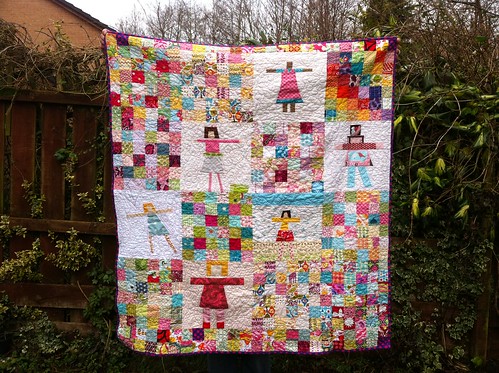 |
| Quilt of Joy by Joy Circle, quilted by Fiona of Poppy Makes |
:: Presentation:: The way in which you present your idea is key to garnering members. Spend time coming up with a name that captures your theme. Also, it's ideal to develop a square graphic or "button" that is like a logo for your bee. You can use this button on your Flickr group or blog as well as share the image with members who might want a bee badge for their blog. If you are not graphically inclined maybe someone who is joining your bee would be willing to make a button?
 |
| Starflower Quilt by Peace Circle, quilted by Michelle of City House Studio |
:: Members:: So, how do you get members? Most folks who start bees are bloggers with small followings. You don't need to be uber popular to start a bee! After doing the work above you have a clear invitation to extend. You can either post a general invitation on your blog or contact people you know from blogland and Flickr to invite on an individual basis. These individual invites tend to be most common, which is why you typically don't hear about a bee until it is already formed. You could also get some members individually and then post an invite on your blog along the lines of "I need 4 more members!" Another place to reach out to people is in this ongoing Flickr thread.
When you invite people, paint a picture of your theme and clearly detail the structure you have in mind. But also be open to feedback, be flexible. Make sure your would-be members know that they'll be expected to follow through the entire way. Expect that some people will decline. This is not about you! We all have lots of obligations, so even a fabulous idea has to be turned down quite often. Remember that and just keep asking!
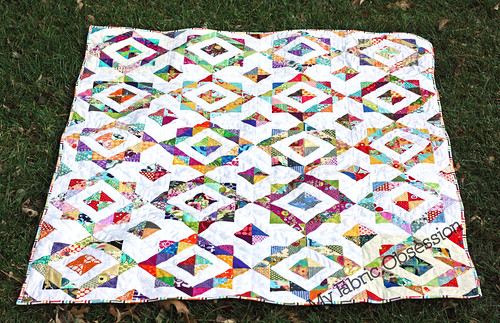 |
| by Bliss Circle, quilted by Becky of My Fabric Obsession |
:: Sticky Situations:: Every bee needs a leader to usher it through those unfortunate events that will pop up. Sometimes blocks will get lost in the mail. Are any members willing to make "angel blocks" to help out or will the missing blocks be replaced by the mailer or perhaps not replaced at all? What if a member is chronically late with her blocks? Be sure to set a deadline for mailing blocks and think about how you can encourage promptness. Sometimes someone disappears altogether. Life can deal us unexpected turns. Unfortunately, drop-outs are a common problem even in bee models that rely on members to stay the course. You can probably replace members who aren't able to continue if their month to quilt has not yet come up (thus the new member will still have a turn to get help on her own quilt). But, if the drop-out's quilt has already been done by your bee, it's going to be tough. That's why it's extremely bad etiquette to drop out of a bee that has already sewn blocks for you. If you find yourself struggling to meet your obligations, be sure to talk to your bee leader. She definitely wants to help find a solution, even if it means lightening your load. The worst thing to do is to disappear without communicating.
 |
| Bento Boxes by Hope Circle, quilted by Kat of BBC Textiles |
I did it and You can to!
When I started do.Good Stitches, I had only been blogging for a few months and had only made 2-3 quilts. I had never been in a bee before. Yes, I was not at all sure that I'd find anyone who would join my bee, but my mama always says, "It never hurts to try!" If you have some sort of admin skills and the passion for it, I'm sure you can start a bee. Just go for it! You'll learn as you go. Be flexible, listen to feedback, give others the benefit of the doubt and above all Have Fun!
 |
| by Harmony Circle, quilted by Denise at My Family Thinks I'm Working |
Quilting bees are so popular precisely because they are a ton of fun. For a quilter, what's better than learning new skills, trying new things and making new friends all at once? I encourage everyone, even if you are really new to quilting, to consider a quilting bee. Just be honest about your skill level. It's nothing to be shy about! Be realistic about how much you can take on, since people will be relying on you, but don't be afraid to volunteer. A dedicated and friendly heart is more important than having perfect points in most cases!
You may also enjoy Alissa Haight Carlton & Kristen Leijnieks' book Block Party: The Modern Quilting Bee
Good luck!